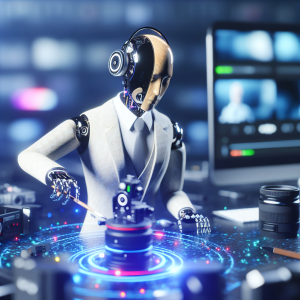-
- Transforming Imagination: AI Video Creation for Hyper-Realistic Content
- Understanding AI Video Creation
- Configuration Steps for AI Video Creation
- Step 1: Choose the Right AI Tool
- Step 2: Set Up Your Environment
- Step 3: Data Collection and Preparation
- Step 4: Model Training
- Step 5: Video Generation
- Practical Examples of AI Video Creation
- Example 1: Marketing and Advertising
- Example 2: Entertainment
- Best Practices for AI Video Creation
- Case Studies and Statistics
- Conclusion
Transforming Imagination: AI Video Creation for Hyper-Realistic Content
In the rapidly evolving landscape of digital content creation, artificial intelligence (AI) has emerged as a transformative force, particularly in the realm of video production. The ability to generate hyper-realistic video content using AI not only enhances creativity but also streamlines workflows, making it accessible to a broader audience. This guide delves into the intricacies of AI video creation, providing actionable steps, practical examples, and best practices to harness this technology effectively.
Understanding AI Video Creation
AI video creation involves using machine learning algorithms and neural networks to generate, edit, and enhance video content. This technology can create realistic animations, deepfake videos, and even generate entirely new scenes based on textual descriptions. The relevance of AI in video production is underscored by its ability to reduce costs, save time, and push the boundaries of creativity.
Configuration Steps for AI Video Creation
To get started with AI video creation, follow these configuration steps:
Step 1: Choose the Right AI Tool
Select an AI video creation tool that suits your needs. Popular options include:
- DeepBrain
- Runway ML
- Synthesia
- DeepArt
Step 2: Set Up Your Environment
Ensure you have the necessary hardware and software. A powerful GPU is recommended for rendering high-quality videos. Install the required software packages, such as:
- Python 3.x
- TensorFlow or PyTorch
- OpenCV for video processing
Step 3: Data Collection and Preparation
Gather and prepare your data. This may include:
- Video clips for training
- Images for style transfer
- Text scripts for generating scenes
Step 4: Model Training
Train your AI model using the collected data. Use the following code snippet to initiate training:
import tensorflow as tf
# Load your dataset
dataset = tf.data.Dataset.from_tensor_slices((images, labels))
# Define your model
model = tf.keras.Sequential([
tf.keras.layers.Conv2D(32, (3, 3), activation=’relu’, input_shape=(height, width, channels)),
tf.keras.layers.MaxPooling2D(pool_size=(2, 2)),
tf.keras.layers.Flatten(),
tf.keras.layers.Dense(128, activation=’relu’),
tf.keras.layers.Dense(num_classes, activation=’softmax’)
])
# Compile and train the model
model.compile(optimizer=’adam’, loss=’sparse_categorical_crossentropy’, metrics=[‘accuracy’])
model.fit(dataset, epochs=10)
Step 5: Video Generation
Once your model is trained, you can generate videos. Use the following command to create a video from your model:
python generate_video.py --model_path path/to/model --output_path path/to/output/video.mp4
Practical Examples of AI Video Creation
AI video creation has been successfully implemented in various industries:
Example 1: Marketing and Advertising
Companies like Coca-Cola have utilized AI-generated videos for personalized marketing campaigns, creating tailored content that resonates with individual consumers.
Example 2: Entertainment
In the film industry, studios are using AI to create realistic CGI characters and scenes, significantly reducing production time and costs. For instance, the movie “The Irishman” employed AI to de-age actors, showcasing the technology’s potential in storytelling.
Best Practices for AI Video Creation
To maximize the effectiveness of AI video creation, consider the following best practices:
- Regularly update your training data to improve model accuracy.
- Utilize high-quality input data to enhance output quality.
- Experiment with different models and algorithms to find the best fit for your project.
- Incorporate user feedback to refine and improve your AI-generated content.
Case Studies and Statistics
According to a report by MarketsandMarkets, the AI in video creation market is expected to grow from $1.1 billion in 2020 to $7.5 billion by 2025, highlighting the increasing adoption of this technology. Additionally, a case study by Adobe revealed that companies using AI in their video production processes saw a 30% increase in efficiency and a 25% reduction in costs.
Conclusion
AI video creation is revolutionizing the way content is produced, offering unprecedented opportunities for creativity and efficiency. By following the configuration steps outlined in this guide, leveraging practical examples, and adhering to best practices, you can effectively harness the power of AI to create hyper-realistic video content. As this technology continues to evolve, staying informed and adaptable will be key to maintaining a competitive edge in the digital landscape.
